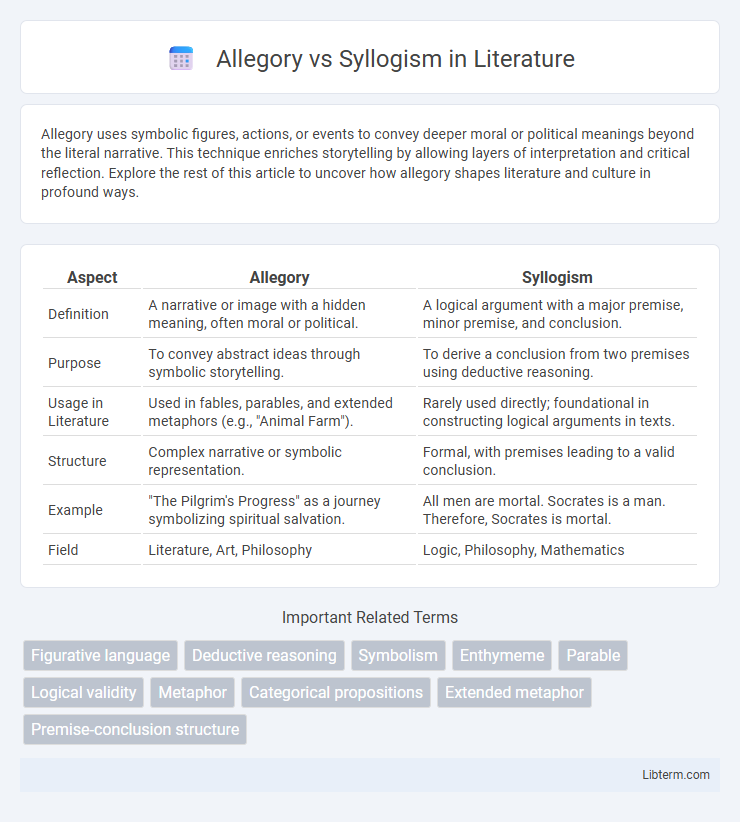Allegory uses symbolic figures, actions, or events to convey deeper moral or political meanings beyond the literal narrative. This technique enriches storytelling by allowing layers of interpretation and critical reflection. Explore the rest of this article to uncover how allegory shapes literature and culture in profound ways.
Table of Comparison
| Aspect | Allegory | Syllogism |
|---|---|---|
| Definition | A narrative or image with a hidden meaning, often moral or political. | A logical argument with a major premise, minor premise, and conclusion. |
| Purpose | To convey abstract ideas through symbolic storytelling. | To derive a conclusion from two premises using deductive reasoning. |
| Usage in Literature | Used in fables, parables, and extended metaphors (e.g., "Animal Farm"). | Rarely used directly; foundational in constructing logical arguments in texts. |
| Structure | Complex narrative or symbolic representation. | Formal, with premises leading to a valid conclusion. |
| Example | "The Pilgrim's Progress" as a journey symbolizing spiritual salvation. | All men are mortal. Socrates is a man. Therefore, Socrates is mortal. |
| Field | Literature, Art, Philosophy | Logic, Philosophy, Mathematics |
Understanding Allegory: A Brief Overview
Allegory is a narrative technique that uses symbolic figures, actions, or imagery to convey deeper moral, spiritual, or political meanings beyond the literal story. Unlike syllogism, which is a logical argument composed of premises leading to a conclusion, allegory relies on metaphorical representation to illustrate abstract ideas. Understanding allegory involves recognizing the layers of meaning embedded in characters and events, revealing insights through interpretation rather than formal logic.
Syllogism Explained: The Basics
Syllogism is a form of deductive reasoning consisting of two premises leading to a conclusion, often structured as major premise, minor premise, and conclusion. It is fundamental in logic, enabling clear argument analysis by connecting general statements to specific instances. Unlike allegory, which conveys meaning through symbolic storytelling, syllogism relies on strict logical relationships to establish truth.
Key Differences Between Allegory and Syllogism
Allegory is a narrative technique where characters and events symbolize broader concepts, often conveying moral, political, or spiritual messages, while syllogism is a form of deductive reasoning consisting of a major premise, minor premise, and a conclusion. Allegory relies on metaphorical storytelling to express abstract ideas through concrete elements, whereas syllogism uses logical structure to derive conclusions from given premises. The key difference lies in allegory's emphasis on artistic representation and interpretation versus syllogism's focus on formal logic and clarity in argumentation.
Historical Origins of Allegory and Syllogism
Allegory originated in ancient literature and philosophy, particularly linked to Plato's works where abstract ideas were conveyed through symbolic narratives. Syllogism was developed by Aristotle in the 4th century BCE as a formal structure of deductive reasoning, essential for classical logic. Both concepts laid foundational roles in Western thought, influencing rhetoric, ethics, and scientific methodologies.
Structure and Components: Allegory vs. Syllogism
Allegory employs symbolic narratives where characters and events represent broader concepts, relying on layers of meaning embedded within a story's structure. Syllogism consists of a formal logical framework with two premises leading to a conclusion, emphasizing clear, deductive reasoning components. The structure of allegory is narrative-based and interpretative, while syllogism is concise and formulaic, prioritizing validity and soundness.
Functions in Literature and Logic
Allegory functions in literature as an extended metaphor, using symbolic figures, actions, or events to convey complex moral, political, or spiritual meanings beyond the literal narrative. In contrast, syllogism operates in logic as a form of deductive reasoning where a conclusion is inferred from two premises, establishing truth through structured argumentation. While allegory enriches understanding through layered interpretation, syllogism aims to prove validity through precise and formalized logical relationships.
Notable Examples of Allegory in Literature
Notable examples of allegory in literature include George Orwell's *Animal Farm*, which uses farm animals to symbolize the Russian Revolution and critique totalitarian regimes. John Bunyan's *The Pilgrim's Progress* is a seminal Christian allegory representing the spiritual journey of salvation. These works demonstrate allegory's power to convey complex moral, political, and philosophical ideas through symbolic storytelling, distinct from the logical structure of syllogism.
Famous Syllogisms in Philosophy
Famous syllogisms in philosophy include Aristotle's classic example: "All men are mortal; Socrates is a man; therefore, Socrates is mortal." This logical structure forms the basis of deductive reasoning, distinguishing it from allegory, which uses symbolic narratives to convey deeper meanings. Syllogisms provide clear argumentative clarity crucial for philosophical analysis and formal logic development.
Applications in Critical Thinking
Allegory enhances critical thinking by encouraging interpretation of abstract ideas through symbolic narratives, fostering deeper understanding of complex concepts and moral lessons. Syllogism applies formal logic to analyze arguments by deducing conclusions from premises, strengthening reasoning skills and the ability to identify logical validity or fallacies. Both methods support critical thinking by offering distinct approaches: allegory cultivates creative insight while syllogism emphasizes structured analytical evaluation.
Choosing Between Allegory and Syllogism
Selecting between allegory and syllogism depends on the intended purpose and audience; allegories convey complex ideas through symbolic narratives, making them effective for moral or philosophical lessons, while syllogisms offer clear, logical arguments grounded in deductive reasoning. Use allegory when aiming to evoke emotional resonance and engage imagination, especially in literature or rhetoric. Opt for syllogism in academic, scientific, or legal contexts where precision and structured proof are paramount.
Allegory Infographic

 libterm.com
libterm.com